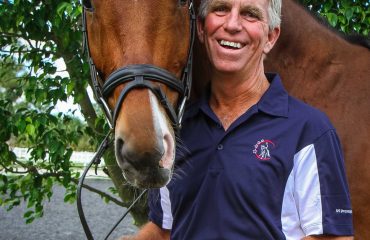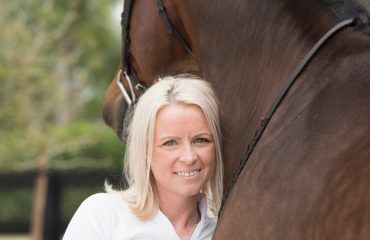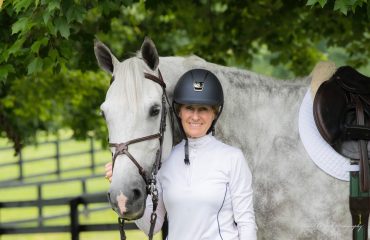
Coming Home II- Painted early in 2018. 30” x 40” acrylic on heavy canvas
By Laurie Berglie
Equestrian artist Lisa Curry Mair has been creating since she was a child. She could be found drawing, doodling and painting, and always had some sort of craft or project in the works. Lisa’s mother brought her up reading the horse books by C.W. Anderson and the Thelwell cartoons, and she soon found herself trying her best to recreate these studies and drawings. Even at a young age, she wanted to learn how to capture a horse’s expressions and emotions.

Lisa with Winslet, known as Kate. Lisa said Kate, who is her 3rd/4th-level dressage horse, is her pride and joy.
In addition to supplying her with arts and crafts materials, Lisa’s mom also instilled in her daughter a love of horses. When Lisa was 5 years old, her mother brought home Bluebell, an adorable pony who taught Lisa the ways of the horse world. Not long after, her passion for riding and artistic talents successfully collided.
When Lisa went to college, she majored in mathematics with a minor in art. Her father was a scientist, so his influence made Lisa feel more secure in the objective nature of math. It was either right or wrong. Art, in her mind, was scary as there is never any true, “correct” answer. But Lisa loved the feeling of creating something that was beautiful and peaceful, so it wasn’t long before she was drawn back to it.
Where’s your studio?
My studio is at my home in a very small town called Weathersfield in Vermont. My horses also live on my property, so I have everything I need right at my fingertips. Home, horses, studio. It’s all here. Sometimes I don’t leave for days! My husband and I have lived here for almost 25 years. The house (and barn) is over 200 years old, and I feel it has adopted me. It’s a magical place with stories to tell.
What’s your artistic style and technique?
I paint in both acrylics and oils. I do a lot of large-scale work on canvas in the form of murals and painted canvas floorcloths, and I use acrylics for those. My framed paintings are now mostly in oils. I enjoy the workability of oils, and I like my work to appear aged, which is better accomplished in oils than acrylics.
My style is what I like to call “nouveau folk.” It reminds the viewer of a simpler time gone by and is a bit more refined than what most people think of as “folk art.” I enjoy portraying farm life, horses and landscapes in peaceful, soft, historic settings.
 Did you ever doubt if you were on the right career path?
Did you ever doubt if you were on the right career path?
It took me a while before I could fully dedicate my career to art. After obtaining my math degree, I co-owned and operated a 30-stall boarding, training and lesson facility. I put all of my energy into the horses until I burned out, took a sharp turn and enrolled in architecture school. It turned out the timing wasn’t right for that, and I ventured into architectural model building for a while, then children’s book illustration, then floorcloth painting. I started my business, Canvasworks, in 1994 and it’s still going strong today, allowing me to reshape the business as I evolve.

Lisa often paints old saddles and donates them to raise money.
What influenced you to start painting tack and other equipment?
I am on the board for the Central Vermont Dressage Association, our local organization. We had an adult camp and one of the suggested activities was to paint old saddles. I offered to teach people how to do it and decided I’d better try doing one first! So I did, and it was a hit. I donated it to a non-profit to auction as a fundraiser. Then it occurred to me that I could paint old boots too, so I did a few of those. My painted boots and saddles have been auctioned to raise money for The Brooke Foundation, Ever After Mustang Rescue and the New England Dressage Association. Last year, $2,500 was raised for the USEF’s Equine Relief Fund after Hurricane Harvey through sales of prints of one of my paintings as well. I enjoy having a way to give back through my painting.

“Mariner’s Compass” floorcloth on the table in progress and “Navigating the Brook” 36” x 72” wall hanging on the wall.
What’s been your biggest accomplishment to date as an artist?
I just had the opening for my first major solo art show at the Arundel Farm Gallery in Arundel, Maine. The show had 35 of my pieces on display – from wall hangings to paintings to a floorcloth and a saddle, most with an equestrian theme.
I also have a piece in Boston’s Museum of Fine Art in the “Art of the Americas” wing. It’s a period reproduction painted canvas floorcloth which makes up part of the display for Paul Revere’s silver.
Have you always been an equestrian?
Since my first pony, Bluebell, I’ve always had at least one horse in my care. I came up through all the levels of Pony Club and showed hunters and jumpers before taking on dressage and eventing. I evented through my 20s and after a few nasty falls, I decided to stick strictly to dressage. Now I focus solely on dressage and enjoy trail riding here in Vermont on down days.
Right now, I have a wonderful mare, Kate, who’s teaching me to communicate with her in ways so subtle that I’ve never felt so in-tune with a horse before. It’s an incredibly long learning curve, and I hope to keep riding that curve until the day I die, because I know I’ll never learn it all. And someday if I can’t do it while sitting on a horse’s back, I hope to do it from the ground. They’re incredible beasts with so much to teach us. I will always be in awe of them.

Hunt scene floorcloth- 7’ x 9’ custom painted canvas floorcloth for a dining room in Virginia’s hunt country.
What’s been your greatest accomplishment as an equestrian?
I love bringing horses up through the levels. Most of my horses have been very green when I got them. There’s great satisfaction in seeing them learn and develop into fine athletes. I also get very attached to them, so most have stayed with me and have lived to a ripe old age and given me the pleasure of caring for them as retired seniors. I feel I owe them every moment they require of me. They’ve taught me how to be patient, kind and giving. The awards from shows only stand as reminders of how hard we worked — fleeting moments of success between days, weeks and months of intense, focused training.
What’s your state of mind while you’re painting?
I often paint first thing in the morning: It’s a wonderful way to start the day. I find it allows me to be quiet and focused, and it allows the creative juices to start flowing right away. I’ve done some of my best work when we’ve had a snowstorm and I can’t do anything else. The quiet of a snowy day is blissful. I also work well when I need to get away from the craziness of the world. When things go nuts, I go paint!
Do you paint from memory, or do you use photographs as references?
I love using my own photos for reference. Sometimes I pull out old encyclopedias for interesting renderings of animals or buildings and will morph them into a new composition. Other times I capture still frames from videos of my own critters, when I’m looking for a unique perspective or interesting light.

Lisa with her mini donkeys, Abner and Thor
What inspires you?
The work of Alfred Munnings, George Stubbs and C.W. Anderson. My horse, Kate. Vermont and its farms and farmers. History. Late afternoon light on a fall day. The quiet of a lake.
What’s next on the horizon for you as an artist? As an equestrian?
Next on my horizon as an artist is allowing myself even more “free” painting time; large works with an interesting look at life with horses, farms, country; searching for more opportunities to show my work in galleries, online and in public places; and teaching others to be creative and to appreciate the creative process.
As an equestrian, Kate and I are knocking on FEI level dressage’s door. This is new territory for both of us, and we are eager to give it all we’ve got!
For more information, visit canvasworksdesigns.com













